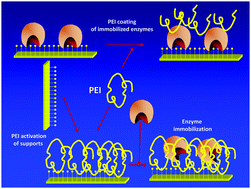Polyethylenimine: a very useful ionic polymer in the design of immobilized enzyme biocatalysts
Abstract
This review discusses the possible roles of polyethylenimine (PEI) in the design of improved immobilized biocatalysts from diverse perspectives. This includes their use to activate supports and immobilize enzymes via ion exchange, as well as to improve immobilized enzymes by coating with PEI. PEI is a polymer containing primary, secondary and tertiary amino groups, having a strong anion exchange capacity under a broad range of conditions, and the capability to chemically react with different moieties on either an enzyme or a support. Also, as a multifunctional polymer, it has been modified stepwise to introduce different functionalities into the same polymer. This polymer (in combination with other anionic ones) permits the generation of “saline” environments around enzyme molecules, improving enzyme stability in the presence of hydrophobic compounds. The use of PEI as a physical glue useful to crosslink enzyme subunits in multimeric enzymes, monomeric enzymes immobilized via physical interactions or production of enzyme multilayers will be specially emphasized as new open avenues for enzyme coimmobilization. The coimmobilization of enzymes and cofactors using PEI may become one of the future developments allowed through an adequate use of this polymer and new pathways towards the design of enzyme combi-catalysts for their use in cascade reactions. Some unexplored but suggested uses derived from the properties of PEI are also proposed in the review, like the use of the buffering power of this multifunctional polymer to avoid pH gradients inside biocatalyst particles. Thus, although PEI has been a largely popular polymer in biocatalyst design, it looks like a long and in some cases almost unexplored road lies ahead.

- This article is part of the themed collection: Recent Review Articles


 Please wait while we load your content...
Please wait while we load your content...